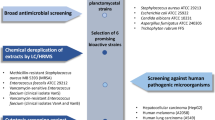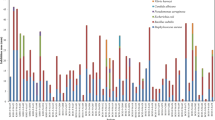Abstract
Antarctica harbors a microbial diversity still poorly explored and of inestimable biotechnological value. Cold-adapted microorganisms can produce a diverse range of metabolites stable at low temperatures, making these compounds industrially interesting for biotechnological use. The present work investigated the biotechnological potential for antimicrobial and antitumor activity of filamentous fungi and bacteria isolated from marine sediment samples collected at Deception Island, Antarctica. A total of 89 microbial isolates were recovered from marine sediments and submitted to an initial screening for l-glutaminase with antitumoral activity and for antimicrobial metabolites. The isolates Pseudogymnoascus sp. FDG01, Pseudogymnoascus sp. FDG02, and Penicillium sp. FAD33 showed potential antiproliferative action against human pancreatic carcinoma cells while showing no toxic effect on non-tumor cells. The microbial extracts from unidentified three bacteria and four filamentous fungi showed antibacterial activity against at least one tested pathogenic bacterial strain. The isolate FDG01 inhibited four bacterial species, while the isolate FDG01 was active against Micrococcus luteus in the minimal inhibitory concentration of 0.015625 μg mL −1. The results pave the way for further optimization of enzyme production and characterization of enzymes and metabolites found and reaffirm Antarctic marine environments as a wealthy source of compounds potentially applicable in the healthcare and pharmaceutical industry.



Similar content being viewed by others
Data availability
The data used to support the findings of this study is available upon request.
References
Acevedo-Barrios R, Rubiano-Labrador C, Navarro-Narvaez D, Escobar-Galarza J, González D, Mira S, Moreno D et al (2022) Perchlorate-reducing bacteria from Antarctic marine sediments. Environ Monit Assess 194(9):654. https://doi.org/10.1007/s10661-022-10328-w
Ashok A, Doriya K, Rao JV, Qureshi A, Tiwari AK, Kumar DS (2019) Microbes producing l-Asparaginase free of Glutaminase and Urease isolated from extreme locations of Antarctic soil and moss. Sci Rep 9(1):1423. https://doi.org/10.1038/s41598-018-38094-1
Bernal SPF, Gritti MA, Dos Santos VP, Ottoni JR, de Oliveira VM, Peichoto ME, Passarini MRZ (2021) Pharmaceutical biotechnological potential of filamentous fungi isolated from textile industry. Arch Microbiol 203(7):3933–3944. https://doi.org/10.1007/s00203-021-02379-3
Carmichael J, DeGraff WG, Gazdar AF, Minna JD, Mitchell JB (1987) Evaluation of a tetrazolium-based semiautomated colorimetric assay: assessment of chemosensitivity testing. Cancer Res 47(4):936–942 (PMID: 3802100)
Chitanand M, Shete HG (2012) Condition optimization and production of extracellular lglutaminase from pseudomonas fluorescens. Int J Pharm Bio Sci 3(3):155–162
Convey P, Peck LS (2019) Antarctic environmental change and biological responses. Sci Adv 5(11):eaaz0888. https://doi.org/10.1126/sciadv.aaz0888
Ding Z, Li L, Che Q, Li D, Gu Q, Zhu T (2016) Richness and bioactivity of culturable soil fungi from the Fildes Peninsula, Antarctica. Extremophiles 20(4):425–435. https://doi.org/10.1007/s00792-016-0833-y
Durthia CP, Polaa M, Kolab AK, Rajulapatia SB (2019) Screening, optimization of culture conditions and scale-up for production of the l-glutaminase by novel isolated Bacillus sps. mutant endophyte using response surface methodology. Biocatal Agric Biotechnol 18:101077. https://doi.org/10.1016/j.bcab.2019.101077
Elshafei AM, Hassan MM, Ali NH, Abouzeid MA, Mahmoud DA, El-ghonemy DH (2014) Purification, kinetic properties and antitumor activity of l-Glutaminase from Penicillium brevicompactum NRC 829. Br Microbiol Res J 4(1):97–115. https://doi.org/10.9734/BMRJ/2014/5098
Figueredo HM, Gonçalves VN, Godinho VM, Lopes DV, Oliveira FS, Rosa LH (2020) Diversity and ecology of cultivable fungi isolated from the thermal soil gradients in Deception Island, Antarctica. Extremophiles 24(2):219–225. https://doi.org/10.1007/s00792-019-01146-z
Gerday C, Aittaleb M, Bentahir M, Chessa JP, Claverie P, Collins T et al (2000) Cold-adapted enzymes: from fundamentals to biotechnology. Trends Biotechnol 18(3):103–107. https://doi.org/10.1016/s0167-7799(99)01413-4
Gudiña EJ, Rocha V, Teixeira JA, Rodrigues LR (2010) Antimicrobial and antiadhesive properties of a biosurfactant isolated from Lactobacillus paracasei ssp. paracasei A20. Lett Appl Microbiol 50(4):419–424. https://doi.org/10.1111/j.1472-765X.2010.02818.x
Hansen KØ, Isaksson J, Bayer A, Johansen JA, Andersen JH, Hansen E (2017) Securamine derivatives from the Arctic bryozoan Securiflustra securifrons. J Nat Prod 80(12):3276–3283. https://doi.org/10.1021/acs.jnatprod.7b00703
Hansen KØ, Isaksson J, Glomsaker E, Andersen JH, Hansen E (2018) Ponasterone A and F, ecdysteroids from the Arctic bryozoan Alcyonidium gelatinosum. Molecules 23(6):1481. https://doi.org/10.3390/molecules23061481
Hong L, Li W, Li Y, Yin S (2023) Nanoparticle-based drug delivery systems targeting cancer cell surfaces. RSC Adv 13(31):21365–21382. https://doi.org/10.1039/D3RA02969G
Jesuraj SAV, Sarker MMR, Ming LC, Praya SMJ, Ravikumar M, Wui WT (2017) Enhancement of the production of l-glutaminase, an anticancer enzyme, from Aeromonas veronii by adaptive and induced mutation techniques. PLoS One 12(8):e0181745. https://doi.org/10.1371/journal.pone.0181745
Margesin R, Schinner F (1994) Properties of cold-adapted microorganisms and their potential role in biotechnology. J Biotechnol 33(1):1–14. https://doi.org/10.1016/0168-1656(94)90093-0
Marx JC, Collins T, D’Amico S, Feller G, Gerday C (2007) Cold-adapted enzymes from marine Antarctic microorganisms. Mar Biotechnol 9(3):293–304. https://doi.org/10.1007/s10126-006-6103-8
Mostafa YS, Alamri SA, Alfaifi MY, Alrumman SA, Elbehairi SEI, Taha TH, Hashem M (2021) l-Glutaminase synthesis by marine Halomonas meridiana isolated from the Red Sea and its efficiency against colorectal cancer cell lines. Molecules 26(7):1963. https://doi.org/10.3390/molecules26071963
Núñez-Montero K, Barrientos L (2018) Advances in Antarctic research for antimicrobial discovery: a comprehensive narrative review of bacteria from Antarctic environments as potential sources of novel antibiotic compounds against human pathogens and microorganisms of industrial importance. Antibiotics (Basel) 7(4):90. https://doi.org/10.3390/antibiotics7040090
Ordóñez-Enireb E, Cucalón RV, Cárdenas D et al (2022) Antarctic fungi with antibiotic potential isolated from Fort William Point, Antarctica. Sci Rep 12(21477). https://doi.org/10.1038/s41598-022-25911-x
Saitou N, Nei M (1987) The neighbor-joining method: a new method for reconstructing phylogenetic trees. Mol Biol Evol 4(4):406
Shah M, Sun C, Sun Z, Zhang G, Che Q, Gu Q, Zhu T, Li D (2020) Antibacterial polyketides from Antarctica sponge-derived Fungus Penicillium sp. HDN151272. Mar Drugs 18(2):71. https://doi.org/10.3390/md18020071
Shi T, Yu YY, Dai JJ, Zhang YT, Hu WP, Zheng L, Shi DY (2021) New polyketides from the Antarctic Fungus Pseudogymnoascus sp. HSX2#-11. Mar Drugs 19(3):168. https://doi.org/10.3390/md19030168
Shivaji S, Prakash JS (2010) How do bacteria sense and respond to low temperature? Arch Microbiol 192(2):85–95. https://doi.org/10.1007/s00203-009-0539-y
Shivaji S, Reddy, GSN, Chattopadhyay MK (2016) Bacterial biodiversity, cold adaptation and biotechnological importance of bacteria occurring in Antarctica. Proc Indian Natl Sci Acad 83(2):327–352. https://doi.org/10.16943/ptinsa/2017/48956
Silva TR, Duarte AWF, Passarini MRZ, Ruiz ALTG, Franco CH, Moraes CB, Oliveira VM (2018) Bacteria from Antarctic environments: diversity and detection of antimicrobial, antiproliferative, and antiparasitic activities. Polar Biol 41(7):1505–1519. https://doi.org/10.1007/s00300-018-2300-y
Singh P, Banik RM (2013) Biochemical characterization and antitumor study of l-glutaminase from Bacillus cereus MTCC 1305. Appl Biochem Biotechnol 171(2):522–531. https://doi.org/10.1007/s12010-013-0371-3
Spiers AS, Wade HE (1976) Bacterial glutaminase in treatment of acute leukaemia. Br Med J 1(6021):1317–1319. https://doi.org/10.1136/bmj.1.6021.1317
Tamura K, Stecher G, Kumar S (2021) MEGA11: molecular evolutionary genetics analysis version 11. Mol Biol Evol 38(7):3022–3027. https://doi.org/10.1093/molbev/msab120
Unissa R, Sudhakar M, Reddy ASK, Sravanthi KN (2014) A review on biochemical and therapeutic aspects of glutaminase. Int J Pharm Sci Res 5:4617–4634
Vachher M, Sen A, Kapila R, Nigam A (2021) Microbial therapeutic enzymes: a promising area of biopharmaceuticals. Curr Res Biotechnol 3:195–208. https://doi.org/10.1016/j.crbiot.2021.05.006
Vasquez YMSC, Gomes MB, e Silva TR, Duarte AWF, Rosa LH, de Oliveira VM (2021) Cold-adapted chitinases from Antarctic bacteria: taxonomic assessment and enzyme production optimization. Biocatal Agric Biotechnol 34:102029. https://doi.org/10.1016/j.bcab.2021.102029
Vicente J, de Celis M, Alonso A, Marquina D, Santos A (2021) Microbial communities present in hydrothermal sediments from Deception Island, Antarctica. Microorganisms 9(8):1631. https://doi.org/10.3390/microorganisms9081631
Wang J, He W, Qin X, Wei X, Tian X, Liao L et al (2015) Three new indolyl diketopiperazine metabolites from the Antarctic soil-derived fungus Penicillium sp. SCSIO 05705. RSC Adv 84:68736–68742. https://doi.org/10.1039/C5RA10828D
Zucconi L, Canini F, Temporiti ME, Tosi S (2020) Extracellular enzymes and bioactive compounds from Antarctic terrestrial Fungi for bioprospecting. Int J Environ Res Public Health 17(18):6459. https://doi.org/10.3390/ijerph17186459
Acknowledgements
This work was supported by the Institutional Program Priority Latin America and the Caribbean EDITAL PRPPG Nº 105/2020 and by the Institutional Program Triple Schedule EDITAL PRPPG Nº 205/2021. The authors are grateful to CNPq PROANTAR 442258/2018-6, Productivity Research Grant Process number 309807/2020-4, CAPES FAPEMIG, INCT Criosfera and FNDCT.
Author information
Authors and Affiliations
Corresponding author
Additional information
Communicated by Moracci.
Publisher's Note
Springer Nature remains neutral with regard to jurisdictional claims in published maps and institutional affiliations.
Supplementary Information
Below is the link to the electronic supplementary material.
Rights and permissions
Springer Nature or its licensor (e.g. a society or other partner) holds exclusive rights to this article under a publishing agreement with the author(s) or other rightsholder(s); author self-archiving of the accepted manuscript version of this article is solely governed by the terms of such publishing agreement and applicable law.
About this article
Cite this article
Camacho, K.F., de Melo Carlos, L., Bernal, S.P.F. et al. Antarctic marine sediment as a source of filamentous fungi-derived antimicrobial and antitumor compounds of pharmaceutical interest. Extremophiles 28, 21 (2024). https://doi.org/10.1007/s00792-024-01339-1
Received:
Accepted:
Published:
DOI: https://doi.org/10.1007/s00792-024-01339-1




